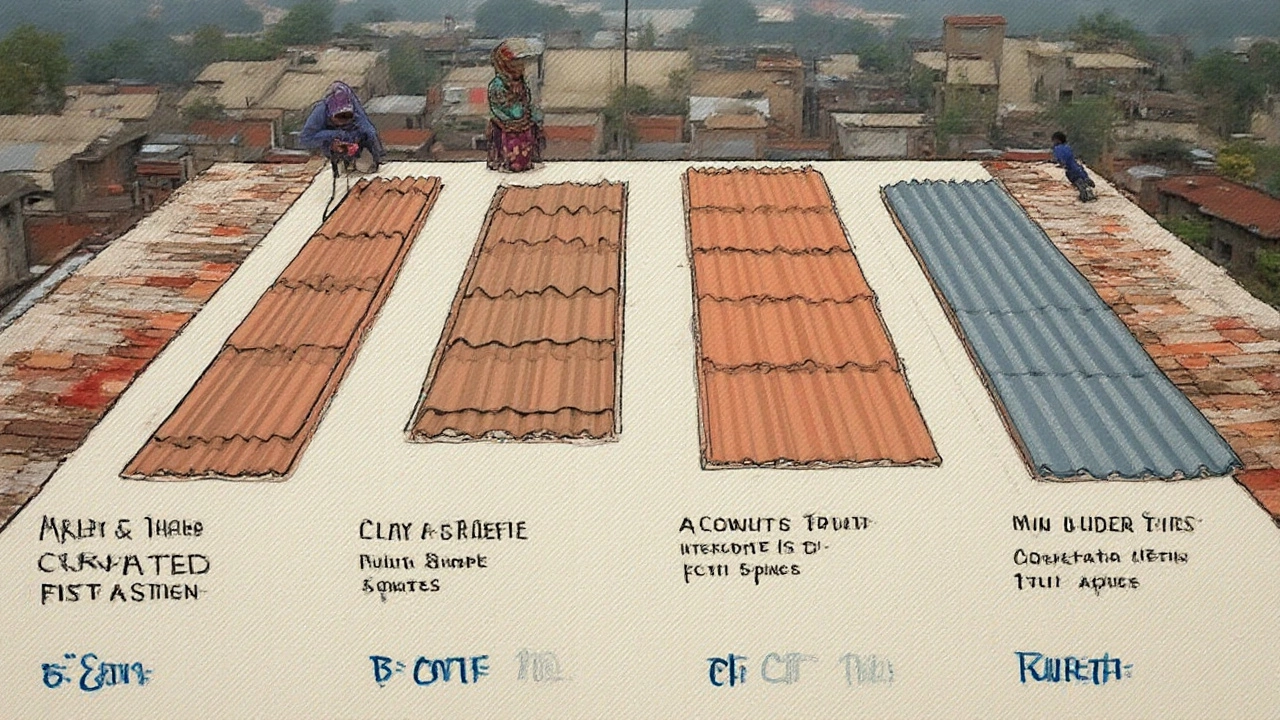Think your leaking old roof is a money pit? You’re not alone. Picking a budget-friendly way to roof your house can feel like playing a rigged game: contractors toss out estimates that boggle the mind, material prices jump every year, and every neighbor seems to have their "secret hack." Yet, here’s the kicker—sometimes the least expensive way to put a roof over your head isn’t the obvious choice at the hardware store. There are some tricks, some gambles, some honest legwork. Let’s lay it all out and separate myths from proven money-savers.
Understanding Roofing Materials: The Cheapest real-world Options
When people talk about cheap ways to roof a house, they’re usually thinking about asphalt shingles for a reason—they’re everywhere, and they really are among the least expensive up-front. But the world of roofs is wider than you might think when it comes to bargains. Let’s break down the contenders, what makes them cheap, and what might cost you more down the line.
Asphalt shingles dominate most suburban roofs in the U.S. because they clock in at somewhere between $90-$110 per roofing square (that’s 100 square feet). Add to that installation costs (which fluctuate wildly depending on region and labor), and you could have a new roof for less than $5,000 if you keep your house small and do some of the prep work yourself. Tough to argue with those numbers if you just need something to last 15-20 years.
But there are even cheaper options—metal panels (the super-thin agricultural type), rolled roofing (basically giant strips of asphalt shingles), and corrugated bitumen sheets. These can drop your material costs even further, but each has its quirks. Rolled roofing may get you a new watertight layer for under $40 per square, but it’ll look, well, cheap. And it doesn’t last: you’ll be patching every few years. Corrugated metal or bitumen is a little more rugged, and a favorite for sheds and ultra-budget cabins, but slapping it on your home won’t win any awards for beauty.
Asphalt shingles offer a sweet spot for most homeowners. They’re so common you can snag deals at big-box stores, their install is straightforward, and if you mess up a section, you can fix it without needing a pro. Here’s a jaw-dropper: if you can hustle, salvage yards or overstock lots occasionally have shingles for next to nothing—sometimes less than $60 a square.
Don’t get tricked into thinking recycled rubber or “green” roofs are truly cheap. Initial material costs often run two or three times higher than basic shingles, and installation can get complicated fast. Vinyl and synthetic shakes claim long-term savings with longer life spans, but you’re going to spend far more up-front.
So why not tar paper or DIY with found materials? Sure, if you’re covering a hunting cabin or a playhouse in your backyard. But tar paper alone won’t survive a real thunderstorm season, and DIY patchwork with random materials? It’ll end up costing more when water starts dripping into your drywall.
One thing folks forget: the cheapest option is always the one you can install yourself safely and correctly. Labor sucks up 40–60% of roof replacement costs for many homes. So if you’re a decent hand with a hammer and ladder, savings stack up quick.
Comparing Labor: DIY vs. Professional Roof Installation
Labor is where budgets expand or shrink. Roofing takes muscle, balance, a tolerance for hot days, and (unless you live in the desert) a willingness to race Mother Nature. So should you DIY, or is hiring a pro secretly less expensive? The answer depends on your time, risk tolerance, and willingness to sweat.
According to the National Roofing Contractors Association, professional install for asphalt shingles will run you between $3 and $6 per square foot. That means labor can double the price you pay for materials. But dig deeper: you’re not just paying for strong backs—you're paying for warranties, insurance, and expertise that can spot trouble (like rotten sheathing or sneaky leaks).
If you want to cut costs, rolling up your sleeves on demolition and clean-up is a start. Vendors will often take $500 to $1,000 off your project if you handle the tear-off yourself. Did your uncle nail his own roof last year? He probably saved around $3,000 on a 1,200-square-foot roof, but he also lived with two weeks of backaches and a sunburn. The best DIYers tend to be those with basic construction know-how and access to the right tools: nail guns, safety harnesses, gigantic ladders.
Roofing isn’t a one-man job on larger homes. If your house is more “small bungalow” than McMansion, rope in a few handy friends. Pizza and cold sodas are convincers, but only if everyone’s clear on safety. Falls are no joke. Building codes and local ordinances also matter; some towns require that roofs get inspected by city officials or only allow certified installers to sign off.
Here’s a tip: Many home improvement retailers offer free or cheap classes on roof installs. Listen to a few in person, and you’ll build up confidence—and probably get a discount on tools or materials just for attending. Some big-box stores even rent you pro-grade nailers and safety gear by the day. That means you can try the “pro” approach yourself without investing in $1,000 worth of gear.
If you do hire a pro, shop around. Get estimates from at least three companies, ask for references, and don’t be afraid to ask them about their material markup. Some companies build hefty profits into those bundles.
As with any hands-on project, the real money-saver is in knowing your limits. It’s better to pay a pro for three days than to DIY and cause leaks that cost thousands later. As the old construction adage goes: "Measure twice, cut once; and if in doubt, call in an expert."

Where to Snag Roofing Materials on the Cheap—And What to Watch For
You’d be surprised where roofers pinch pennies on supplies. Big home improvement chains are convenient, but sometimes small local builders’ supply houses run sales or need to clear out discontinued colors and styles. Don’t care if your shingles are last season’s shade? That can cut 20% right off the bill.
Classified ads, Craigslist, Facebook Marketplace, and local buy-sell boards often list excess building supplies from both contractors and homeowners. Sometimes you’ll find unopened bundles of shingles or rolls of underlayment half-price or less. There’s even a subculture of roofers who book jobs during the off-season when manufacturers dump surplus stock. Early spring and late fall? Prime time to hunt.
If you’re up for it, here’s an unusual—but legal—route: ask local contractors if they have leftover bundles from a larger project. Shingles aren’t always returned to the supplier, so crews might have four or five squares left over they’re willing to sell at a deep discount just to get them out of their trucks. Just check the batch numbers—mixing lots can sometimes lead to minor color fades.
Salvage yards and construction recycling centers offer another avenue. Plenty of old shingles, metal panels, and even clay roofing tiles get a second life for pennies on the dollar. Just be cautious; used roofing needs to be in decent shape. If the edges are brittle or the material is warped, it’s probably not a bargain.
One word to the wise: steer clear of counterfeits. The roofing industry, believe it or not, has its share of knockoffs—especially on synthetic underlayments and imported metal. If the deal seems wildly too good, ask for the packaging label or check with a reputable roofing supplier. No homeowner needs a batch of underlayment that turns out to be glorified felt paper.
Found a weird deal online? Don’t forget to ask about warranties. Unused but "aged" shingles—those that sat in a hot warehouse for two years—might not come with any manufacturer’s guarantee. Save money, sure, but not at the cost of getting left in the lurch when something goes wrong.
Construction supply swaps and habitat-for-humanity type non-profits sometimes provide leftover roofing materials for free or a minimal donation. These have saved DIYers thousands. And you’d be shocked at the quality of stuff that sometimes pops up—think high-end architectural shingles for gutter prices.
Hidden Costs: What the Cheap Approach Might Miss
Every bargain chase comes with hidden costs if you’re not careful. The cheapest roofing may not always be the best fit for your weather, your local building codes, or your home’s warranty. Buy 3-tab asphalt shingles, and you could be getting just 12-15 years out of them, compared to premium architectural ones that push 30. Is saving $3,000 now worth re-roofing before your mortgage is up?
Cheap roofs sometimes cut corners on underlayment or proper ventilation. Those aren’t just nerdy add-ons—bad venting traps moisture and heat, cutting your shingle life in half and possibly voiding manufacturer warranties. A rushed install, even with good shingles, leads to tabs flipping up in heavy winds or rain leaking around your vents and chimneys. Suddenly, your “cheap roof” costs more in repairs than you ever wanted to spend.
If you’re tempted by metal, double-check whether your insurance company covers budget agricultural panels on residential properties. Some policies exclude “non-standard” installations, and you could get stuck with a slick roof but a denied claim after a hail storm.
There’s even resale value to consider. If you’re planning on selling your home in the next few years, a cheap roof might spook buyers, especially if it looks patchy or mismatched. Realtors frequently talk about “curb appeal,” and buyers tend to factor roof replacement in their negotiations if they spot a bargain install.
Locals experience this every season: buying out-of-region materials isn’t always a win. Shingles designed for a Florida climate might fail quickly in a snowy Midwest winter. Always check those regional codes, and don’t let someone sell you Southern shingles for a Northern house.
"You don’t always save money in the long run by choosing the least expensive materials. Sometimes, investing a little more upfront buys you years of peace of mind," says Tom Silva, technical expert from This Old House.

Actionable Tips to Get Your Roof Done for Less (Without Regrets)
If you want the absolute cheapest way to roof your house without risking leaks, headaches, or resale drama, here’s how to stack your odds in your favor:
- Pick 3-tab asphalt shingles from a reputable brand. They’re affordable, effective, and easy to install or patch.
- Shop supply sales, overstock lots, salvage yards, and classified ads for surplus bundles.
- Handle the teardown, cleanup, and prep work yourself if you’re confident—just stay safe with ladders and debris.
- If you DIY, rent the right tools instead of buying. Pay the extra for a proper nail gun and safety gear.
- Ask local contractors for leftover or end-of-job material. Sometimes you can get enough squares for a breezeway or addition for a song.
- Stick to local codes and climates—cheaper southern shingles don’t last up north, and some cheap panels won’t pass inspection.
- Double-check every deal for warranty info and expiration dates.
- Get three or more estimates from pros, and don’t commit until you’ve checked references and material cost markups.
- If you’re planning to sell soon, keep curb appeal in mind. You want "inexpensive," not "obviously cheap."
- Don’t forget about insurance—make sure your cheaper roof still meets policy standards.
There’s a delicate balance between saving money and future-proofing your home. The surest savings come from smart shopping, picking the right material for your house and climate, and knowing when to call in help. The absolute lowest price rarely lines up with the best long-term move, but that doesn’t mean you have to go broke just to stay dry. If you play it right, you can pull off a cost-effective, solid roof with some hustle and a dose of stubborn determination.

